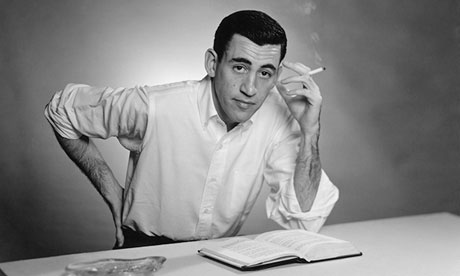
After the war, in which he survived the D-day landings at Utah Beach, Jerome David Salinger holed himself away in a studio in Westport, Connecticut, to finish his first novel. He was 27 years old and had carried a draft of the first six chapters of the book, called The Catcher in the Rye, with him during the fighting in Normandy. Salinger had endured just about the most brutal war imaginable. His regiment advanced through France one field, one village at a time. Of 3,100 men who landed on D-day, only about 500 arrived at Kaufering IV, a concentration camp near Buchenwald, which they "liberated" in the spring of 1945.
Like most of those who were faced with that final horror, Salinger hardly spoke about what he witnessed at that camp. His novel, mostly written in the bucolic peace of Westport after 1947, didn't sound like a war book, not in the way that those books of his contemporaries, Norman Mailer's The Naked and the Dead, or Joseph Heller's Catch-22 did, but it was a war book all the same.
When what he called "the novel about the prep school boy", a boy desperate to recapture ruined innocence (one early incarnation of its voice was called "The Last and Best of the Peter Pans") was finished in 1950, Salinger visited his friend at the New Yorker magazine, William Maxwell, and read out The Catcher in the Rye to him in its entirety. After some deliberation, the magazine decided not to publish any of the book. In a letter to Salinger, it was explained that the New Yorker's editors thought it undone by "writer-consciousness", that the author seemed "imprisoned" by its mood. The book was also rejected by the publisher Harcourt, Brace on the grounds that the language of the preppy Holden Caulfield, all his goddams and hells, "will kill our school division business".
When the editor there asked Salinger if his character was "supposed to be crazy", he noticed that the writer was quietly weeping. The book was eventually published by Little, Brown, on the understanding that Salinger would do no publicity for it and would be sent none of its reviews. In making clear his decision not to talk about his book, Salinger wrote: "I can't explain what I mean. And even if I could, I'm not sure I'd feel like it." The Catcher in the Rye, the author's only published novel, went on to sell 65m copies and Salinger, famously, kept to his word.
It is taken as a given, these days, that the primary reason anyone might want to write a book, or anything, would be to have it published, to make it a success, to communicate with readers. The price of that success is an unwritten contract that allows those readers to dwell on the biographical imperatives that might have produced that book, which, if it is a good one, might reveal something of the author's inner life. Salinger rejected that contract, having seen all that it might entail. There is an argument that he wrote, like many write, only to make sense of things for himself, to externalise and perhaps find some precise comedy in that "imprisoning" mood. In any case, after the story "Hapworth 16, 1924" appeared in the New Yorker in 1965, the rest, for nearly half a century until his death, aged 91, in 2010, was silence.
That silence was never going to survive Salinger's passing. Having fought while alive unstinting legal battles to protect his privacy, and what looked like his sanity or even his soul, the Salinger "industry", that thing he most feared, has cranked up in earnest in the years since 2010. One certainty about David Shields and Shane Salerno's book, and the documentary film that goes with it, is that Salinger would have hated it. He would have hated it not just for its raking over of all that he kept to himself, his love letters, his war record, his search for solace in Buddhism and Vedanta Hinduism, not just its speculative psychoanalysis, its inferences about his relationships with teenage girls, about his sexual anxieties (at one point, the authors suggest his reclusion was a result of a rumour that he had only one testicle, "surely one of the many reasons he stayed out of the media glare was to reduce the likelihood that this information about his anatomy would emerge…"), but most of all he would have hated it for its clamour of voices, its promise of explosive revelation, its blockbuster loudness.
Co-author David Shields argued in his 2010 book Reality Hunger for writing as "collage", for the boundary between fiction and non-fiction to be porous, for forms that are alive to the moment to appropriate and cut and paste with freedom. Salinger is exhibit A for that manifesto; it pieces together fragments from other published books and recorded interviews and archives, so that it reads as notes towards a biography rather than a biography itself. Aspiring to a sort of crowd-sourced portrait, it ends up adding cumulative noise to the myths of its subject's life without ever convincingly approaching what appeared to be the determined quietness of the reality.
Oddly, the books themselves are hardly examined; there is next to nothing in the way of close reading of any of Salinger's painstaking prose – just gobbets dropped in alongside the anecdote, memoir and hearsay. For all its collaged quest for intimacy, the most telling chapter of the book is therefore the short addendum in which it is suggested that a series of new books and stories from the last half of Salinger's life will be "published in irregular instalments starting between 2015 and 2020". It remains to be seen if these will be, as the authors confidently predict, "the masterworks for which he is ever known", but it is likely that they will explain more of what Salinger meant than anything in these pages.

